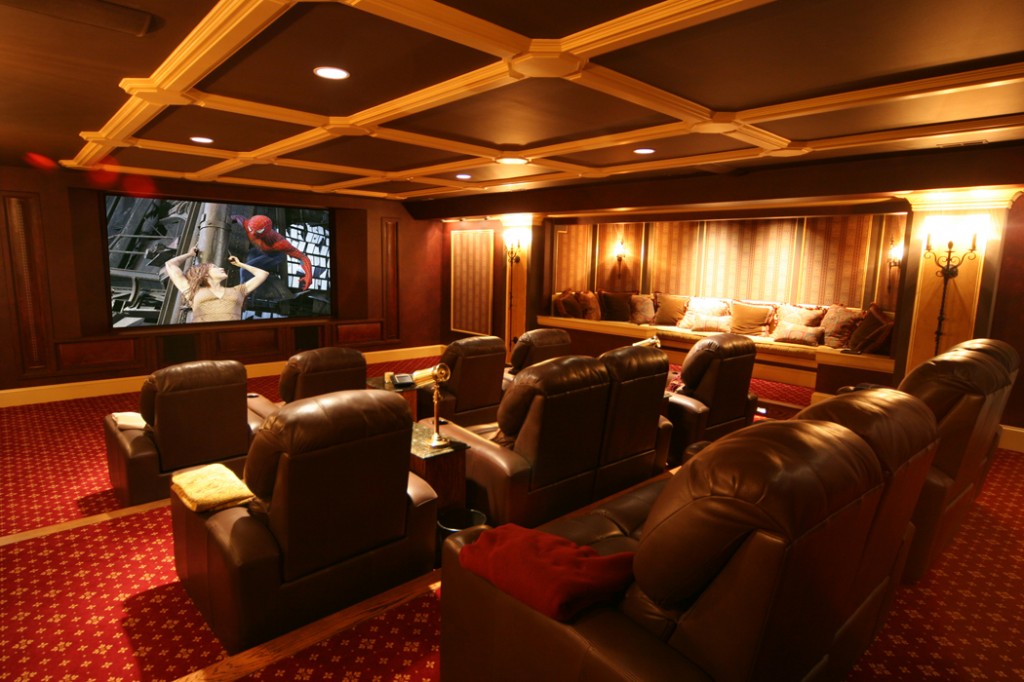The acoustic environment is often overlooked in home theater design. I have seen thousands of dollars worth of audio equipment placed in a room that is entirely hard wood floors, dryall, and glass throughout. The effect is a highly muddled, boomy, echoing, fluttering listening experience with generally disappointing sound quality. Ever wonder why speakers sound better (clearer highs and tighter bass response) on the store showroom than they do at home? The answer is the room. This is why audio salesman take you into a special listening room to test the speakers; it is an acoustically tuned space! I would like to show you how to bring that experience home.
AcousticsFREQ.com has compiled a complete guide to Home Theater acoustic design. This page includes how-to tutorials for creating a world-class environment to enjoy your favorite film, television, music, and video games. Please follow all of the following steps. It is important that you perform each step in order, since the precise location of acoustic treatment depends on the location of speakers and listener seating positions, which must be carefully positioned according to a specific geometry.
Step 1) Determine Surround Sound Speaker Placement – Properly arrange the seating locations, video display, and 5.1 channel surround sound speakers in your home theater space.
Step 2) Find Where to Place Sound Absorbing Treatment – Find the specular reflection points that will require sound absorbing treatment.
Step 3) Build Your Own Sound Absorbing Panels – Make and install cheap, easy, attractive DIY acoustic wall panels
Step 4) Install Sound-Absorbing Drapery – Cover your sound-reflective glass and window surfaces with retractable and highly absorptive acoustic black out curtains
Follow these four steps to the letter and you have everything you need to enjoy a world class cinema experience right in your home! Please send me comments, questions or photos of your finished masterpiece and I will add them to this page: Eric@AcousticsFREQ.com
Have questions? Please feel free to comment below, or on any of the topic pages.





Is it so differcult to do that I need to get a company like Cinematech involved ? Or can I just put up sound panels covered with drapes throughout the room !
Cinematech is wanting $35,000 to install and provide all materials to totally make the room perfect for high s and low tones. Please give me your advice. Thanks
Tom, that seems very expensive, but they are probably going to provide a very professional install with good visual aesthetics. Construction and architectural projects are expensive. If you follow the steps on this page you will also get a very good outcome for a tiny fraction of that cost, but it will be a lot of work. The only treatment I did not cover is bass traps, which may not be necessary if the walls are single layer drywall.
AcousticsFREQ – So are you saying that a room with single layer drywall does not require sound panels? Our room is a concrete room (four walls and floor with no windows) which will be finished out in drywall (obviously). Are the sound dynamics the same in this type of situation as say an interior room with or without windows?
Rachel, Gypsum board walls and windows will generally be sound reflective. However, they may absorb some very low frequency energy through diaphragmatic effects. I think you saw my statement that bass traps may not be necessary in lightweight drywall construction and are interpreting that as meaning sound absorption treatment in general is not necessary. That is incorrect. I recommend taking every step in this guide for a drywall room. If you have masonry walls, you may also need to employ bass traps to tighten the low frequency (subwoofer) sound. Bass traps are not covered in the tutorial, but there are lots of references about them online.
Can you expand on the tricks of ½” gypsum board and sound absorption and reflection? I’m currently planning out acoustic panels for my home theater. House was built in ‘95, wood frame, slab, ½” drywall throughout. 14’ vaulted ceilings. I have pretty bad echoing and some dead bass spots. Behind the wall my tv is hung from is the master bedroom, on that side of the wall is ½” drywall on ¼” (or so) plywood. I’m looking at bass traps and controlling the wall reflections (to control echo).
Lightweight gypsum board walls are naturally sound absorptive at low frequencies. It is actually difficult to get good reflections from 1/2 drywall when you want them for musical support. I would evaluate the need for bass traps after installing your wall treatments. I don’t think they are always necessary, but people will disagree with me on this.
What height are acoustic panels placed?
Hello Mary,
Please see my article here for the answer to your question regarding placement of the panels: http://acousticsfreq.com/where-to-place-acoustic-treatment-in-a-home-theater/